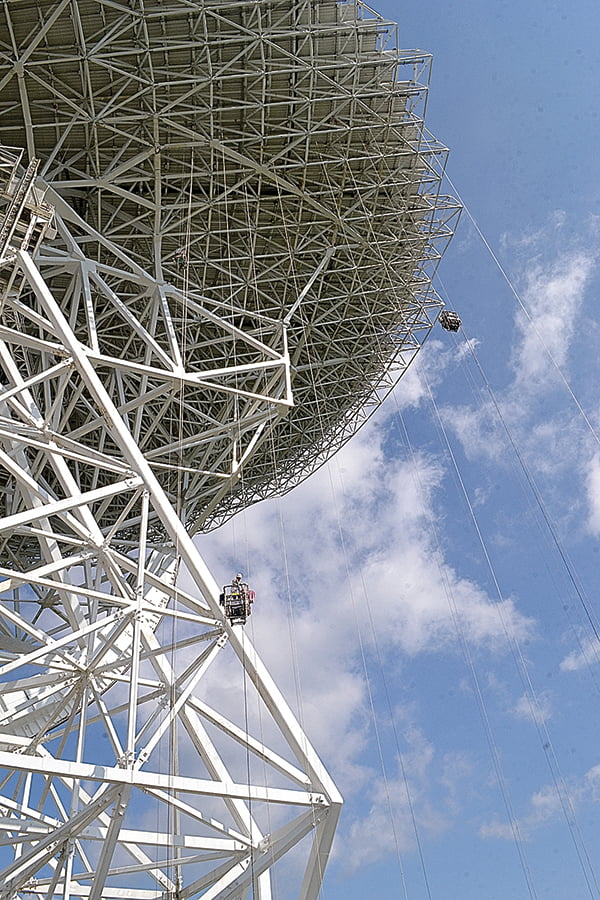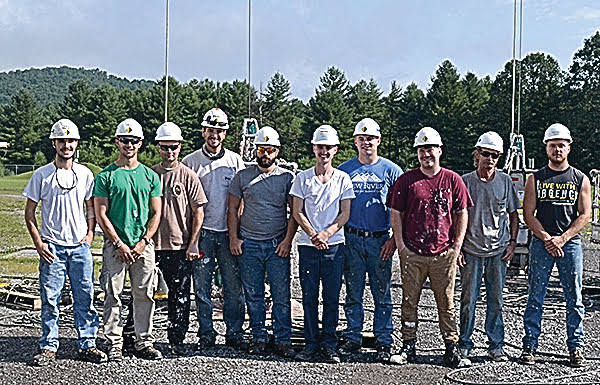
Suzanne Stewart
Staff Writer
There is no denying that the Green Bank Telescope is a one-of-a-kind instrument, and the individuals who work with it are making some of the most groundbreaking discoveries in astronomy, science and engineering.
With the focus on the work of the telescope, it’s easy to forget the people who maintain it and make sure all its parts are in working order.
Those are the summer workers – the ones who replace car-sized plates on the telescope’s tracks and hang 200 feet in the air in buckets to paint the steel structure underneath the dish.
It may only be a summer job, but it is “the” summer job that leaves a lasting impression.
This year’s crew includes returning painters Curtis Bennett, of Durbin; Ryan Irvine, of Marlinton; Billy Cassell, of Dunmore; and Dustin Dilley, of Marlinton; and new members, Taylor Lane, of Jacksonville, Florida; Andrew Pritt, of Huntersville; Logan Davis, of Edray; Shane Peacock, of Huntersville; Brian Dianas, of Dunmore; and Michael Sumner, of Dunmore.
The crew works under the guidance of Bob Anderson, head of telescope operations, who starts them off with an orientation and safety session before setting them loose on the telescope.
“We put them in their harnesses, get them accustomed to feeling those and then we hoist them by their back ring – that’s where the tethers are attached,” Anderson said. “If they fall out of their basket, the straps through their legs would tend to cut off circulation, so we have emergency straps that they can deploy and step up into and relieve that pressure until they are rescued.
“Once they understand how to attach and un-attach from a basket in the warehouse, they come out here and we get them in their basket,” he continued. “We let them go up about [100 feet] after lunch on the first day. We’ve had a few over the years that have said, ‘you know, I just don’t think I can do this.’ They’ll go find other work, but if they can do it, then we feel pretty good that they’re going to be able to do the rest of the job.”

While none of the painters in the past have ever fallen out of the baskets, it’s good to be prepared, Anderson said. It also helps the painters get accustomed to wearing harnesses and knowing their limitations.
It may seem like a job that is impossible for anyone who has a fear of heights, but as the crew discusses the job, several admit that they suffer from fear of heights.
“If you’re not scared the first time you go up there, there’s something wrong with you,” Peacock said.
“Over the course of the first week, you just try to get used to it all,” Layne added.
They each find a way to compartmentalize what they are doing to get the job done – whether they focus on the small area around them or try to enjoy the views.
“When I’m out on the edge, I always consider that the top of the world,” Dianas said. “That’s what I would say – it’s the edge of the world out there.”
Day-to-day duties revolve around the weather and as long as the sky is clear, the crew is on the telescope.
“If weather permits or other circumstances don’t arise, we’re up painting right underneath the dish,” Bennett said. “We’re hanging from the spider baskets under the dish where the catwalks are.”
The spider baskets are one-man baskets equipped with tools of the trade, including brushes, scrapers and paint.
“We have these metal containers that hang on the side,” Dianas said. “One of them is your top coat, one of them is your primer. You put a gallon or two in there and that will last you for a little while. We have all different types of tools. We have ropes on the side we use for tying off. If you’re hanging in the middle of nowhere, floating in the air, tie off to a beam and you can swing and pull yourself around a little bit to get closer.”
As the crew goes up in their baskets, at least one member stays on the ground to ensure nothing gets tangled and that everyone is safe.
“I watch them when they go up because the cables can get hung up on the crates,” Cassell said.
“Billy serves as our grounds person,” Anderson added about Cassell. “You can’t just throw people in a basket. He helps get all the materials together. He keeps track of all the supplies and the cables down here, and helps get them rigged.”
Along with painting the panels in the dish and the structure underneath, the crew also replaces the top plates of the telescope’s track. To keep things running smoothly, a layer of bronze teflon material is placed between two plates which make up the track.
As Anderson explained, it’s similar to standing on a 2×8 wooden board which is held up by two concrete blocks. The board will sag from the weight on it, so to keep the board from bending, a second board is placed on top and, while the boards will still sag, it won’t be as significant as it is with a lone board.
“Steel does the same thing and to minimize the effect of that, we put a layer of bronze teflon material between the plates and every year we replace that,” he said. “So, we have to lift every plate, we inspect them, look for damage and replace them if necessary, and put that layer of bronze back down.”
There are a total of 48 plates on the track and only a few are replaced each year. Each plate weighs roughly 4,400 pounds, as much as a car.
Replacing the track was a learning experience for the crew, who got insight into the mechanics of the telescope.
“This GBT is massive, and it’s a lot of fun to walk around and all, but it’s really just interesting – the engineering aspect of it and design of it,” Layne said. “Especially during the track brake portion of it when we had to replace it, that was interesting to learn about. There’s metal plates in there that can become cracked or worn with use, and we just have to replace those with new plates and make sure that the bolts are secure, and pretty much make sure it’s smooth and will run. It’s a really messy job.”
When the crew is faced with bad weather, like much of this summer, they don’t sit idle, waiting to return to their spider baskets. They keep busy with odd jobs around the site, including painting buildings and working wherever they are needed.
With summer slowly coming to an end, the crew members are preparing to return to school or enter the workforce. Bennett and Pritt are both substitute teachers for Pocahontas County High School; Peacock plans to go into law enforcement; and Layne, Irvine and Davis are going back to college to earn their degrees.
Wherever they go, the crew is prepared for the frequently asked questions – or FAQ – which they are bound to hear when they say they painted the GBT.
“Are we crazy? How do you do it? How do you stand the heights? That’s the big ones,” Bennett said of the questions asked. “It takes some time to get used to, but you get used to it. Being my third year, you don’t even pay attention to where you’re at. You just focus on your job and what you need to do, do it and it just becomes second nature.”



